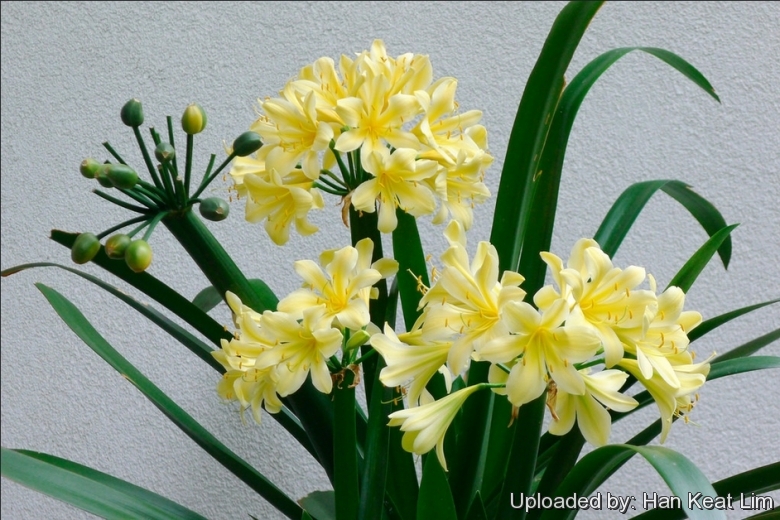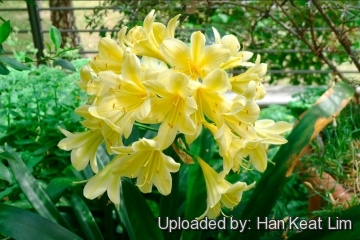Accepted Scientific Name: Clivia miniata (Lindl.) W.R.Abraham
Vollst. Handb. Bl.-Gärtn., ed. 3 1: 768 (1859) et: Gartenfl. (1864) 131.

Clivia miniata var. citrina Photo by: Han Keat Lim
Origin and Habitat: Clivia miniataSN|11020]]SN|11020]] var. citrina is presumed to come from the Midlands and Zululand as well as along the Coast in South Africa. Many different forms of this plant are in cultivation today, and what makes the situation confusing is that in most cases the origin of the plants in question is unknown.
Synonyms:
See all synonyms of Clivia miniata
back
Accepted name in llifle Database:Clivia miniata (Lindl.) W.R.AbrahamVollst. Handb. Bl.-Gärtn., ed. 3 1: 768 (1859) et: Gartenfl. (1864) 131.Synonymy: 10
Accepted name in llifle Database:Clivia miniata f. variegata hort.Synonymy: 2
Cultivars
(2):
back
Common Names include:
ENGLISH: Yellow Clivia
Description: The tipical Clivia miniataSN|11020]]SN|11020]] var. citrina is the much sought-after yellow variety of Clivia miniataSN|11020]]SN|11020]] distinguished by pale creamy-yellow flowers, often with a tinge of orange at the base and in addition it possesses a well shaped cluster, with good broad segments. It is uncertainty as to whether the plants were collected in the wild, or whether they are the result of years of being under cultivation, where they might have been hybridised with other forms.
Derivation of variety name: The specific epithet "citrina" is derived from the Latin "citrum" (=lemon), meaning lemon yellow; referring to the colour of the flowers.
Flowers: Trumpet-shaped with broad overlapping tepals, with a faint, but very sweet perfume. The inner tepals are usually broader than the outer tepals. The normal colour of the flowers is orange with a yellowish-white throat, but var. citrina has distinctly different flowers that are pale butter-yellow. Clivia miniataSN|11020]]SN|11020]] var. citrina is one of the parents of many pure yellow hybrids some of which are highly attractive and have large horticultural potential. The flowers are borne in an umbel supported by a peduncle up to50 cm tall, and the umbels can have in excess of 40 flowers, although 20 is more usual.
Subspecies, varieties, forms and cultivars of plants belonging to the Clivia miniata group
Bibliography: Major references and further lectures
1) “Gardening Illustrated”, Volume 28 1907
2) John Weathers “The Bulb Book” Applewood Books, 01 February 2009
3) RHS "A-Z encyclopedia of garden plants." United Kingdom: Dorling Kindersley. 2008. p. 1136.
4) Neil G. Odenwald, James R. Turner "Identification, Selection, and Use of Southern Plants: For Landscape Design" Claitor's Law Books and Publishing, 15/Dec/2006
5) Susin Leong, Tracy Loughlin "Colour Guide to Flowering Perennials" Murdoch Books, 2003
6) Kristo Pienaar "Gardening with Indigenous Plants: Easy to Grow Southern African Plants" Struik, 1994
7) Shane Smith "Greenhouse Gardener's Companion: Growing Food and Flowers in Your Greenhouse Or Sunspace" Fulcrum Publishing, 2000
8) John C. Manning, Colin Patterson-Jones "Southern Africa Wildflowers: Jewels of the Veld" Struik, 2004
9) James Cullen, Sabina G. Knees, H. Suzanne Cubey "The European Garden Flora Flowering Plants: A Manual for the Identification of Plants Cultivated in Europe, Both Out-of-Doors and Under Glass" Cambridge University Press, 11/Aug/2011
10) Ben-Erik Van Wyk, Fanie Van Heerden, Bosch Van Oudtshoorn "Poisonous Plants of South Africa" Briza Publications, 2002
 Clivia miniata var. citrina Photo by: Han Keat Lim
Clivia miniata var. citrina Photo by: Han Keat LimSend a photo of this plant.The gallery now contains thousands of pictures, however it is possible to do even more. We are, of course, seeking photos of species not yet shown in the gallery but not only that, we are also looking for better pictures than those already present.
Read More... Cultivation and Propagation: Clivias are outstanding houseplant; easy to grow, need little care and flower late winter. Few plants flower so brilliantly in the shade as the clivias, and the flower stems can be cut for arrangements, too.
Exposure: Be aware that full sun will burn the leaves. They need some shade and require far less sun than most flowering plants. They will grow well under trees, on the north side of your house, in a shaded area in the greenhouse or in rooms of your house that receives indirect light or curtain filtered light.
Soil: Clivias should be potted in a rich, but well well-drained soil (for example: peat, fine pine bark mulch and lava great ) a pH 5.5-6.5 best suits them. The soil should never become soggy or water sodden, but should drain well even when watered often.
Repotting: Clivias bloom and perform best when allowed to become rootbound, so don’t overpot them in a pot that is too large, they really love being crowded in a pot, so leave them undisturbed for many years. When you repot your clivias place one or more small, empty pots upside down on the bottom of the container will enhance drainage. Do not plant them too deep! The roots should be covered with only a 0,5 cm of soil.
Watering: Regular irrigation is beneficial.
Feeding: Use balanced slow release fertilizer, every three months, but any complete fertilizer will do.
Temperature: USDA ZONE 9-10. If they are kept at room temperature and watered year round they will grow into lovely plants, but they will not flower. Inducing them to flower is easy. In the Fall and Winter keep them cool 10° C. Keep them dry to interrupt the growth cycle and initiate bud formation. Do this from November until January giving water about once a month. Then water less sparingly until flower buds appear after which they can be displayed anywhere. They are a very welcome sight in late Winter. Once your plant blooms the first time, it will usually bloom about the same time each year.
Traditional medicine: The rhizome is used by the Zulu to treat fever. The whole plant is used to help with childbirth and to hasten parturition. The rhizome is also a snake-bite remedy and it is claimed to relieve pain.
Warning: The rhizomes of Clivia species are extremely toxic due to the presence of lycorine and other alkaloids, making it poisonous. Their continued use should be strongly discouraged.
Pruning: Remove old leaves and stems.










